I want to shade a THREE.BoxBufferGeometry using a simple THREE.MeshLambertMaterial. The material is supposed to use a Lambert illumination model to pick the colors for each vertex (and it does), and then use Gouraud shading to produce smooth gradients on each face.
The Gouraud part is not happening. Instead, the cube's faces are each shaded with one single, solid color.
I have tried various other BufferGeometrys, and gotten inconsistent results.
For example, if instead I make an IcosahedronBufferGeometry, I get the same problem: each face is one single, solid color.
geometry = new THREE.IcosahedronBufferGeometry(2, 0); // no Gouraud shading.
geometry = new THREE.IcosahedronBufferGeometry(2, 2); // no Gouraud shading.
On the other hand, if I make a SphereBufferGeometry, the Gouraud is present.
geometry = new THREE.SphereBufferGeometry(2, 3, 2); // yes Gouraud shading.
geometry = new THREE.SphereBufferGeometry(2, 16, 16); // yes Gouraud shading.
But then if I make a cube using a PolyhedronBufferGeometry, the Gouraud shading doesn't appear unless I set the detail to something other than 0.
const verticesOfCube = [
-1,-1,-1, 1,-1,-1, 1, 1,-1, -1, 1,-1,
-1,-1, 1, 1,-1, 1, 1, 1, 1, -1, 1, 1,
];
const indicesOfFaces = [
2,1,0, 0,3,2,
0,4,7, 7,3,0,
0,1,5, 5,4,0,
1,2,6, 6,5,1,
2,3,7, 7,6,2,
4,5,6, 6,7,4
];
const geometry = new THREE.PolyhedronBufferGeometry(verticesOfCube, indicesOfFaces, 1, 1); // no Gouraud shading
geometry = new THREE.PolyhedronBufferGeometry(verticesOfCube, indicesOfFaces, 1, 1); // yes Gouraud shading
I am aware of the existence of the BufferGeometry methods computeFaceNormals() and computeVertexNormals(). Normals are emphatically important here, as they are used to determine the colors for each face and vertice, respectively. But while they help with the Icosahedron, they have no effect on the Box, no matter whether they are present, only one is present, or both are present in both possible orders.
Here is the code I expect to work:
const geometry = new THREE.BoxBufferGeometry(2, 2, 2);
geometry.computeFaceNormals();
geometry.computeVertexNormals();
const material = new THREE.MeshLambertMaterial({
color: 0xBE6E37
});
const mesh = new THREE.Mesh(geometry, material);
I should be getting a cube whose faces (the real, triangular ones) are shaded with a gradient. First, the face normals should be computed, and then the vertex normals by averaging the normals of the faces formed by them. Here is a triangular bipyramid on which correct Gouraud shading is being applied:

But the code above produces this instead:

At no point does three.js log any errors or warnings to the console.
So what is it that's going on here? The only explanation I can think of is that the Box is actually comprised of 24 vertices, three at each corner of the cube, and that they form faces such that each vertex's computed normal is an average of at most two faces pointing in the same direction. But I can't find that written down anywhere, and that explanation doesn't fly for the Polyhedron where vertices and faces were explicitly specified in code.